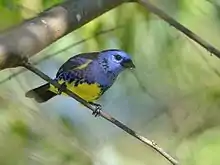Turquoise tanager
The turquoise tanager (Tangara mexicana) is a medium-sized passerine bird in the tanager family Thraupidae. It is a resident bird from Trinidad, Colombia and Venezuela south to Bolivia and much of Brazil (despite its scientific name, it is not found in Mexico). It is restricted to areas with humid forest, with its primary distribution being the Amazon, while a disjunct population occurs in the Atlantic Forest of eastern Brazil. The latter population is sometimes considered a separate species, the white-bellied tanager (Tangara brasiliensis) .
| Turquoise tanager | |
|---|---|
 | |
| Scientific classification | |
| Kingdom: | Animalia |
| Phylum: | Chordata |
| Class: | Aves |
| Order: | Passeriformes |
| Family: | Thraupidae |
| Genus: | Tangara |
| Species: | T. mexicana |
| Binomial name | |
| Tangara mexicana (Linnaeus, 1766) | |
| Synonyms | |
|
Tanagra mexicana Linnaeus, 1766 | |
It occurs in forest, woodland and cultivation. The bulky cup nest is built in a tree or shrub, and the female incubates three brown-blotched grey-green eggs.
These are social birds usually found in groups. They eat a wide variety of fruit and also take insects, often gleaned from twigs.
Taxonomy
The turquoise tanager was formally described in 1766 by the Swedish naturalist Carl Linnaeus in the 12th edition of his Systema Naturae under the binomial name Tanagra mexicana.[2] His description was principally based on Mathurin Jacques Brisson's Le tangara blue de Cayenne that he had described and illustrated in 1760.[3] The type locality is Cayenne in French Guiana.[4] The turquoise tanager is now placed in the genus Tangara that was introduced by Brisson.[5][6]
Five subspecies are recognised:[6]
- T. m. vieilloti (Sclater, PL, 1857) – Trinidad
- T. m. media (Berlepsch & Hartert, 1902) – east Colombia and Venezuela
- T. m. mexicana (Linnaeus, 1766) – the Guianas to central Brazil
- T. m. boliviana (Bonaparte, 1851) – southeast Colombia to east Ecuador, east Peru, west Brazil and north Bolivia
- T. m. brasiliensis (Linnaeus, 1766) – southeast Brazil
Description
Adult turquoise tanagers are 14 cm long and weigh 20 g. They are long-tailed and with a dark stout pointed bill. The adult is mainly dark blue and black, with turquoise edging to the primaries. Most races have yellow lower underparts, but this is paler, more cream in the nominate subspecies found in north-eastern South America. The Trinidadian race, T. m. vieiloti, has a darker blue head and breast and more vividly yellow underparts than the mainland taxa, but this difference is only obvious compared to the nominate and brasiliensis. The taxon brasiliensis differs conspicuously from all other races, it being larger, having an overall duller blue plumage, blue edging to the primaries and a white belly. Their song is a fast squeaky chatter tic-tic-tic-tic-tic.
Gallery
 T. m. brasiliensis with pale blue plumage, blue primary edging and white belly is sometimes considered a separate species
T. m. brasiliensis with pale blue plumage, blue primary edging and white belly is sometimes considered a separate species.jpg.webp) T. m. vieiloti from Trinidad is the darkest subspecies
T. m. vieiloti from Trinidad is the darkest subspecies
References
- BirdLife International (2012). "Tangara mexicana". IUCN Red List of Threatened Species. 2012. Retrieved 26 November 2013.CS1 maint: ref=harv (link)
- Linnaeus, Carl (1766). Systema naturae : per regna tria natura, secundum classes, ordines, genera, species, cum characteribus, differentiis, synonymis, locis (in Latin). Volume 1, Part 1 (12th ed.). Holmiae (Stockholm): Laurentii Salvii. p. 315.
- Brisson, Mathurin Jacques (1760). Ornithologie, ou, Méthode Contenant la Division des Oiseaux en Ordres, Sections, Genres, Especes & leurs Variétés (in French and Latin). Volume 3. Paris: Jean-Baptiste Bauche. p. 6, Plate 1 fig. 3.
- Paynter, Raymond A. Jr, ed. (1970). Check-List of Birds of the World. Volume 13. Cambridge, Massachusetts: Museum of Comparative Zoology. p. 361.
- Brisson, Mathurin Jacques (1760). Ornithologie, ou, Méthode Contenant la Division des Oiseaux en Ordres, Sections, Genres, Especes & leurs Variétés (in French and Latin). Paris: Jean-Baptiste Bauche. Vol. 1 p. 36 and Vol. 3 p. 3.
- Gill, Frank; Donsker, David; Rasmussen, Pamela, eds. (July 2020). "Tanagers and allies". IOC World Bird List Version 10.2. International Ornithologists' Union. Retrieved 17 October 2020.
External links
- Xeno-canto: audio recordings of the turquoise tanager
- Turquoise Tanager videos on the Internet Bird Collection
- Stamps (for Suriname) with RangeMap–(shows the disjunct range in coastal SEast Brazil)
- Turquoise Tanager photo gallery VIREO

